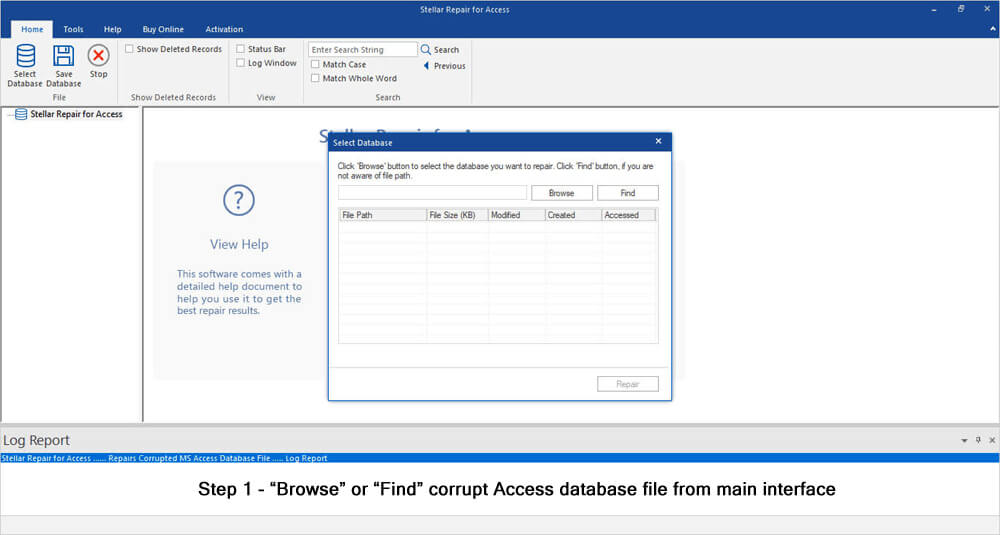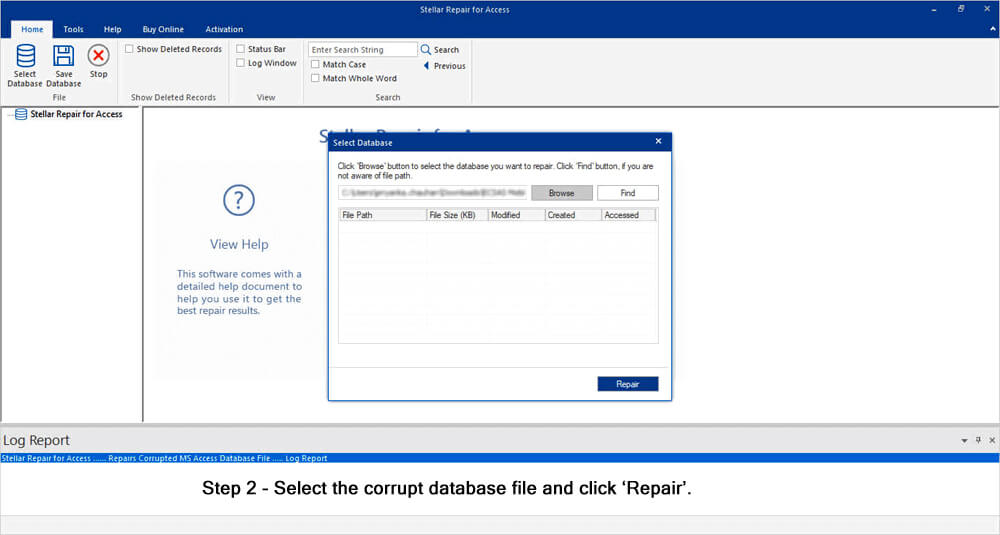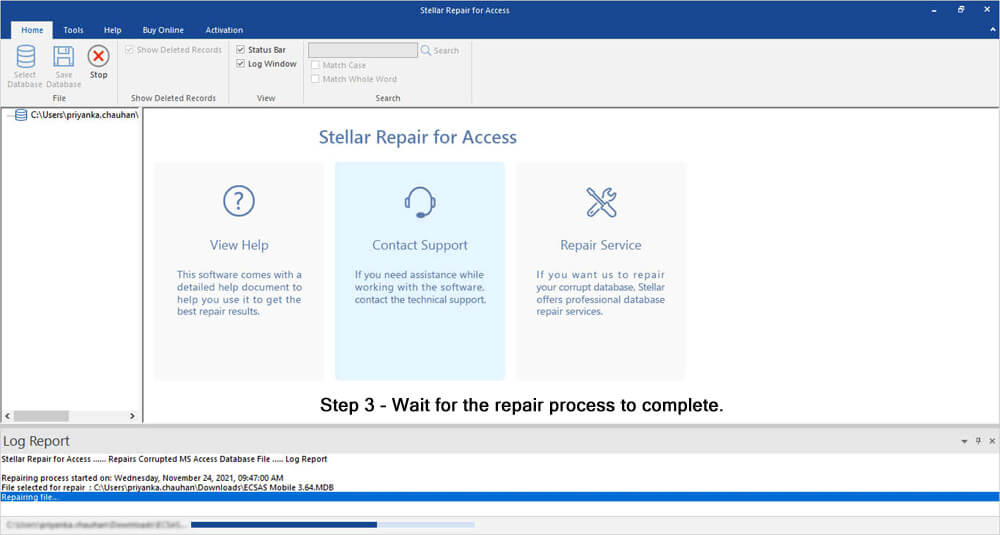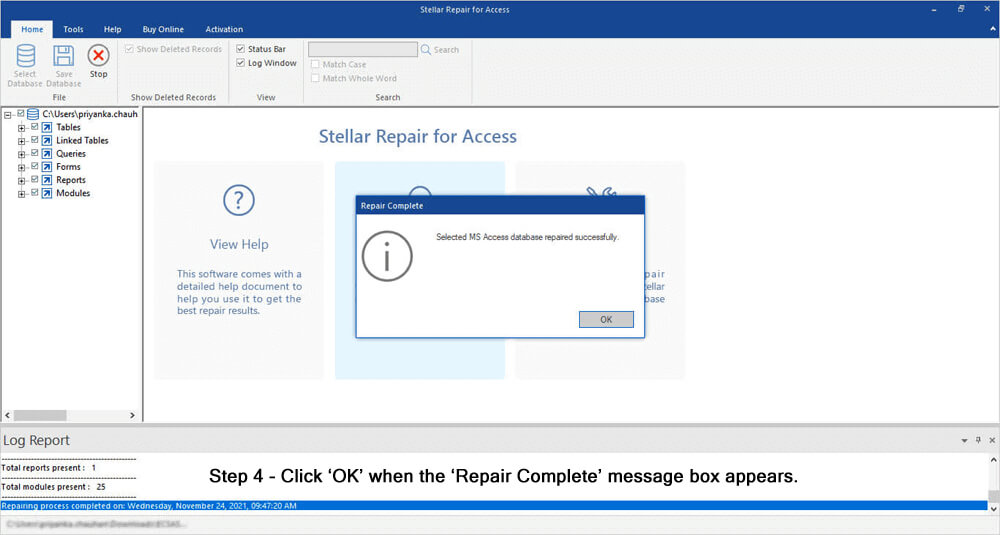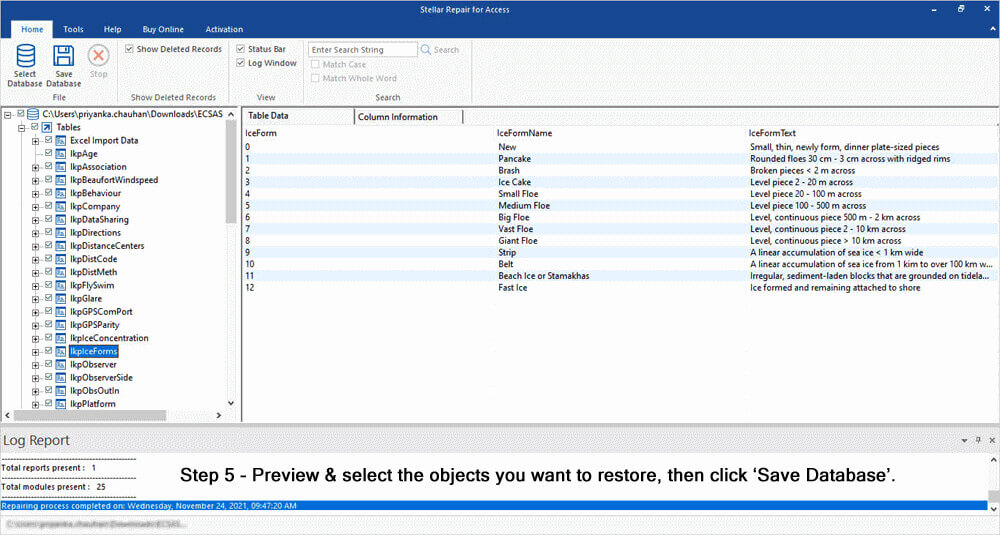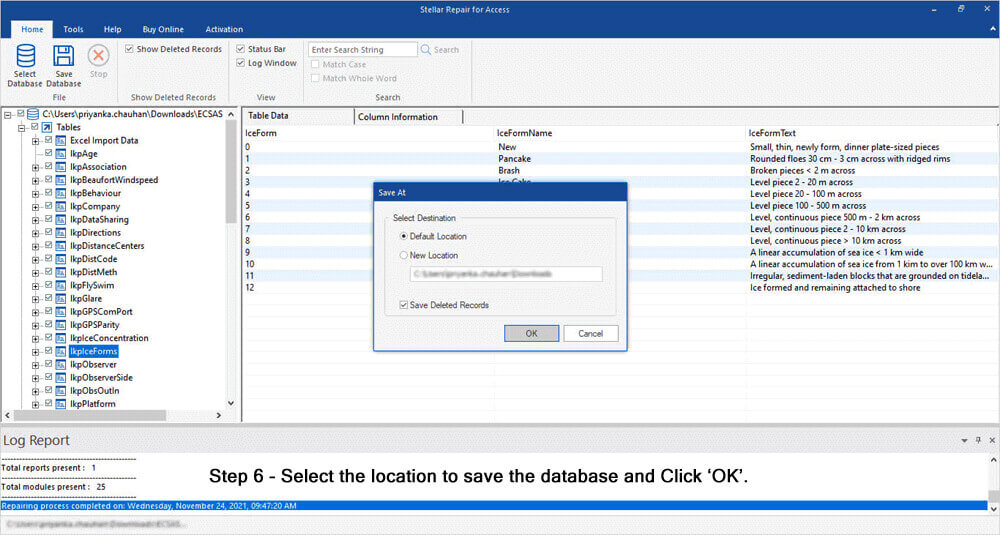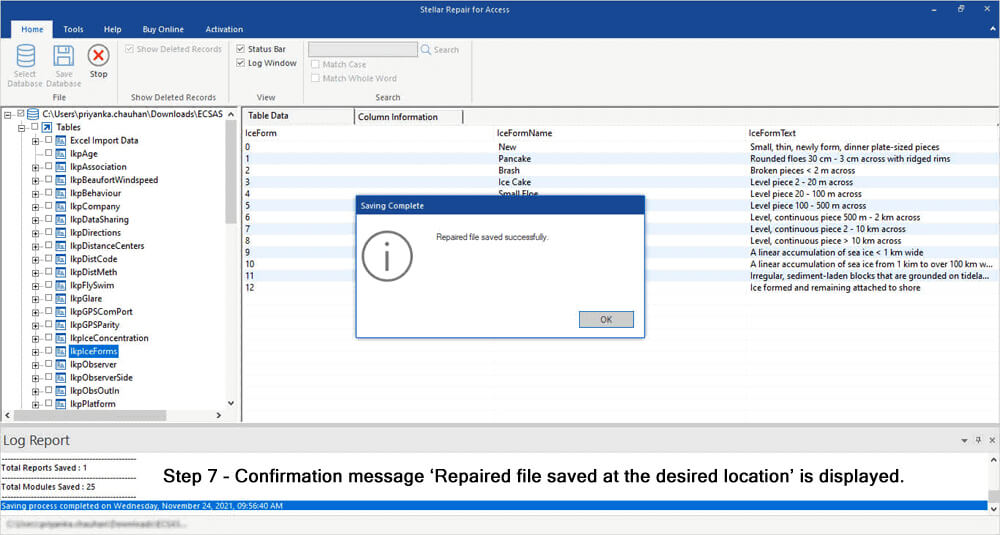Encountered a dreaded error message “Microsoft Access could not lock file” when trying to lock your Access database (.mdb or .accdb) file? Don’t worry, I am here to help you to overcome this frustrating situation. This blog describes the possible causes and a few workable solutions to solve this warning in a hassle-free manner.

Also, I will mention a proficient Access Repair Tool to fix could not lock file. (error 3050) if it has occurred due to file corruption.
Free MS Access Database Repair Tool
Repair corrupt MDB and ACCDB database files and recover deleted database tables, queries, indexes and records easily. Try Now!
By clicking the button above and installing Stellar Repair for Access (14.8 MB), I acknowledge that I have read and agree to the End User License Agreement and Privacy Policy of this site.
Quick Fixes:
- Check Network Connectivity
- Delete Lock File
- Check for File Permissions
- Prevent Opening Of Access Database In Exclusive Mode
- Disable the Antivirus Software
- Convert the Old Access 97 Version Of The MDW File To New
- Repair Corrupted Access Database
Before directly jumping into the detail fixes, let’s see one of the real user’s scenarios who is actually facing the same error:
Practical Scenario
I am working on a network and every PC/Laptop has been updated to the latest Microsoft update, but we are still having issues trying to use our Access database. Please let me know what else I can try to solve “opening database (rescache /) failed io error could not lock file”?
Source: Microsoft-Community.Com
What Does Could Not Lock File. (Error 3050) Mean?
When this warning message occurs in MS Access, it simply means that multiple users are trying to access the same database at the same time, and there is an issue with file locking or permissions. In simple words, one user’s changes are stopping another user from making changes in the DB file.
Methods to Fix Microsoft Access Could Not Lock File Error
Let’s find out the fixes to try:
Method 1- Check Network Connectivity
If you have stored your Access database on a network drive, then ensure that there is a strong internet connection. Because weak or unstable network connections can cause locking issues and can display this error message.
Method 2- Delete Lock File
MS Access lock files (ldb) are one such temporary file that gets created each time with the creation of a new file in the Access database. It automatically gets deleted by itself when you close your MS Access database program. But sometimes they don’t get deleted by themselves and this raises problems including this error.
When these stubborn Access lock files won’t get deleted by themselves then you need to delete them manually. For this, you have to search this MS Access locking files in your entire hard drive. You can easily recognize it as they have .idb extension. In the search criteria type *.ldb and delete all the .ldb file you get to solve this error.
Method 3- Check for File Permissions
Another effective solution that can help you troubleshoot opening database (rescache /) failed io error could not lock file is to check for file permissions.
You have to ensure that the folder holding the database has the necessary permissions for all the users who used to access the database. Also, make sure that users have read & write permissions to access the folder & database file.
Method 4- Prevent Opening Of Access Database In Exclusive Mode
Another very obvious reason behind this error could not lock file Access is that your database is opened in exclusive mode.
Chances are high that another user has opened your database in exclusive mode and has made modifications like module editing. Close your Access database completely and once again open it normally without choosing the exclusive mode option.
HELPFUL ARTICLE: Resolve Access Error “You Don’t Have Exclusive Access To The Database At This Time”!
Method 5- Disable the Antivirus Software

As mentioned in the causes section, the enabled antivirus program can interfere with a locking mechanism and can lead to this error. In such a case, it is recommended to disable the antivirus software immediately after facing this error.
Method 6- Convert the Old Access 97 Version Of The MDW File To New
Note: This solution applies to MDB files, not the ADP or the ACCDB files.
If your Access database is not opened exclusively then another reason behind the 3050 error can be:
- If in case the two instances of MS Access (DAO database engine) are using diverse system MDW files then this will create conflict.
In this situation, the database starts appearing exclusively locked by some other instance.
- MDW file, which is used by your MS Access instances, can easily be checked in the VBA codes by checking the DBEngine.SystemDB value.
Copy of MS Access or DAO may have opened your database using another MDW file and thus this causes the conflict. This issue may be raised in the MS Access instance, VBA Add-in, MS Access add-in, or library reference. Or with some other application program like VB6, .NET, etc. which is being connected to the database.
Workaround:
To avoid such a situation, ensure that your entire MS Access instance is pointing to the same MDW file mainly if you are using the workgroup security.
It is also defined within the shortcut used for launching MS Access.
Or when you are trying to open the Access database programmatically, within the VBA code.
Convert Old Access 97 Version of the MDW File
If you are using Access 2000 or its later version, then chances are high that you are still using the MDW file in Access older version. This generates Access database error could not lock file.
As we all know Access 2000 has come up with a new file format i.e MDB.
You can say “MDW” is an older Access database file format just like the latest Access database (mdb or accdb) file format.
Even though the latest Access database version can also open the older Access 97 database version files. But for this you need to convert them, here are the steps that you need to be followed:
- Create a complete backup of the MDW file that you have.
- Now try opening the MDW database in your Access application.
- If your MS Access file is in Access 97 format then your Access application will ask you to convert this to the latest MDB file format.
- After making the conversion, now you can freely use your new MDW just like the workgroup security file.
Method 7- Repair Corrupted Access Database
Sometimes, Microsoft Access could not lock file (error 3050) occurs due to database corruption. In such a situation, you can use Access’s built-in utility- Compact and Repair to optimize the Access database file & repair it.
Follow the below steps to use this tool:
- Open Access application.
- Then, go to the File > Info.
- Finally, click on Compact & Repair Database.

Now, you will get a copy of the compacted & repaired file at the same location as the original database.
However, if the Compact & Repair tool fails to solve the issue, you can try the first-rate Access Repair Software. It can fix corrupted Access database (.MDB/.ACCDB) files along with recovering all the components, such as tables, records, queries, reports, etc. So, you can download this tool from the below-given button to repair your corrupt database.

* By clicking the Download button above and installing Stellar Repair for Access (14.8 MB), I acknowledge that I have read and agree to the End User License Agreement and Privacy Policy of this site.
Steps to Use Access Database Repair Freeware Tool
Other Workarounds To Resolve Access Database Error Could Not Lock File.
Other than the above-mentioned fixes you can try some more tricks to fix Access could not lock file error.
- Split your Access database into front-end and Back-end.
- Instead of MDB distribute your Access database Front-end MDE
- Deploy only the Front-end application into all user’s local PC
- Don’t run the update queries on those records in which users are already doing editing.
- Don’t let the binding data entry forms within the multi-table query.
- Redesign the tables to reduce its records size (mainly the OLE and the Memo fields).
Also Read: Effective Strategies for Access Not A Valid Bookmark. (Error 3159)
Common Causes of This Error
However, there are various potential reasons for the occurrence of this error:
1. Network Related-Issues
If the Access database is saved over the network & there are network issues when trying to access it.
2. File Permissions
If MS Access does not have the required permissions to read/write to the file, then Access won’t be able to lock that file.
3. Antivirus Software
Sometimes, the antivirus or security tools can interfere with the Access’s ability to lock a file.
4. Due to Database Corruption
Access database corruption can happen due to numerous reasons, like hardware failures, improper shutdowns, virus attacks, etc. which can trigger MS Access could not lock file error.
5. The File Is in Use
If a database file is opened by another user or another application, it can stop you from accessing or locking the file.
How Do I Lock an Access Database?
To lock an Access database, you can set a strong password to protect it from unauthorized access. To do so, follow these steps:
- Firstly, open MS Access >> go to the File tab >> Open.
- Next, click on the Browse option to select an Access file that you need to encrypt.

- Now, click on Open list arrow >> choose Open Exclusive.

- Go to a File tab >> click the Encrypt with Password.
- In the Password field, you have to type a password, re-enter the password in a Verify field >> click OK.

Related FAQs:
Can Updating MS Access Software Solve the Locking File Error?
Yes, updating the MS Access program is a crucial step for solving numerous errors, including locking file problems.
How Often Should I Create Backups of My MS Access Databases?
You should regularly create backups to keep your data safe, preferably before making any significant changes.
Are There Preventive Measures to Avoid Future File Locking Errors?
Yes, there are some preventive measures to avoid future Access file-locking errors, including optimizing database design, keeping the Access software up to date, and backing up the databases, which can minimize the risk of file-locking errors.
When Should I Seek Professional Help for MS Access Issues?
If you encounter complex issues or are unable to resolve errors on your own, seeking professional help is advisable.
Wrap Up
If you strictly follow all the guidelines I have mentioned in this post then you can easily fix off this Access database could not lock file error. So try the fixes and do share your experiences with us, whether the problem has been resolved or not. Even if you are dealing with any other error or issue in your Access database, ask it in Repair MS Access social Facebook and Twitter account.
References:
- https://support.microsoft.com/en-us/office/encrypt-a-database-by-using-a-database-password-12aa0e5c-34c6-4957-af3b-b5f5cfa9a766
- https://techcommunity.microsoft.com/t5/access/could-not-lock-file/td-p/3053251
 Still having issues? Fix them with this Access repair tool:
Still having issues? Fix them with this Access repair tool: This software repairs & restores all ACCDB/MDB objects including tables, reports, queries, records, forms, and indexes along with modules, macros, and other stuffs effectively.
- Download Stellar Repair for Access rated Great on Cnet (download starts on this page).
- Click Browse and Search option to locate corrupt Access database.
- Click Repair button to repair & preview the database objects.
